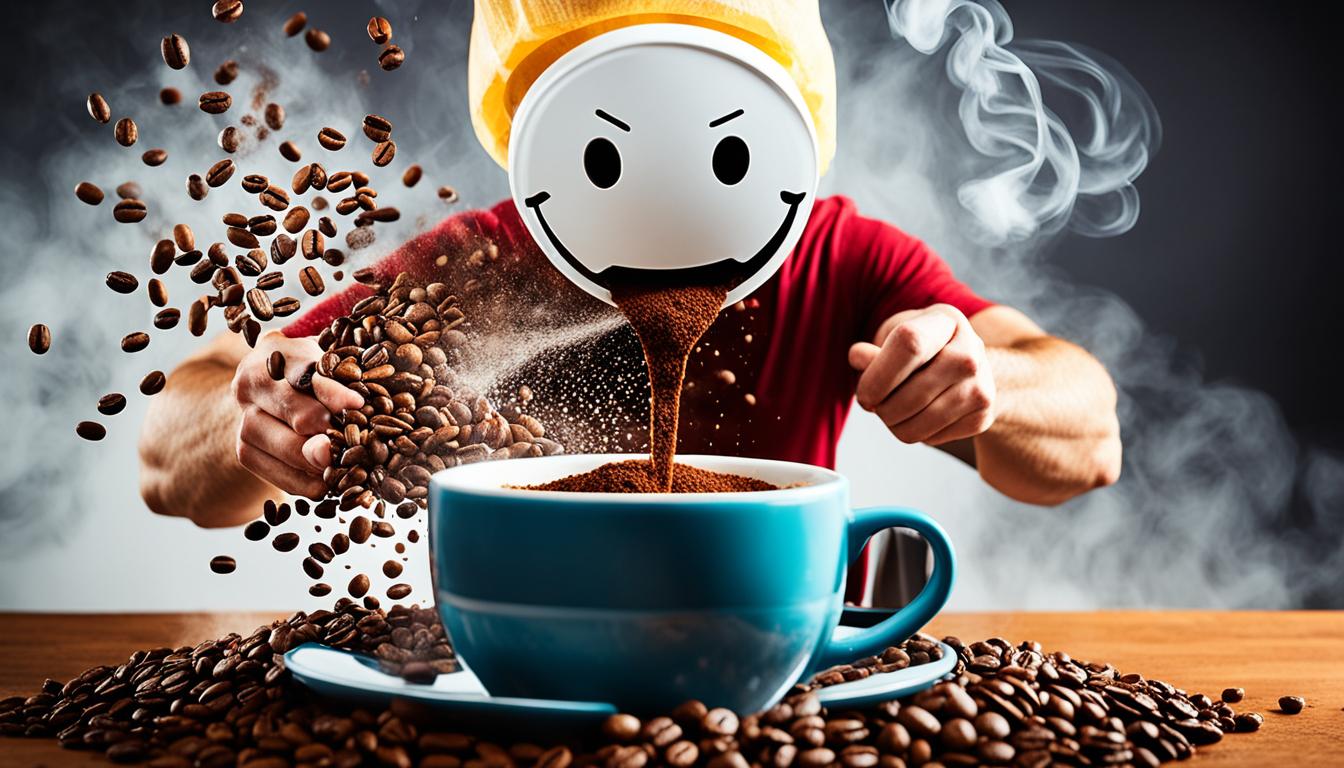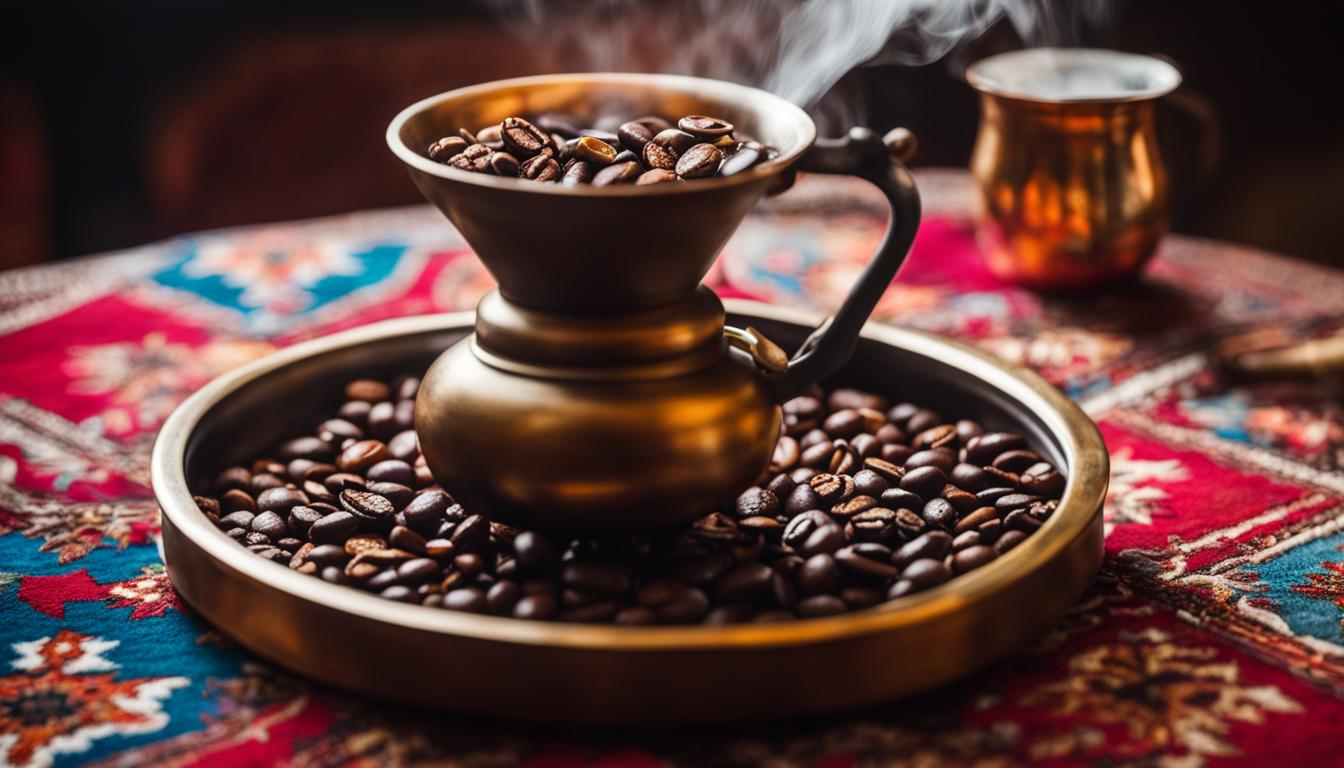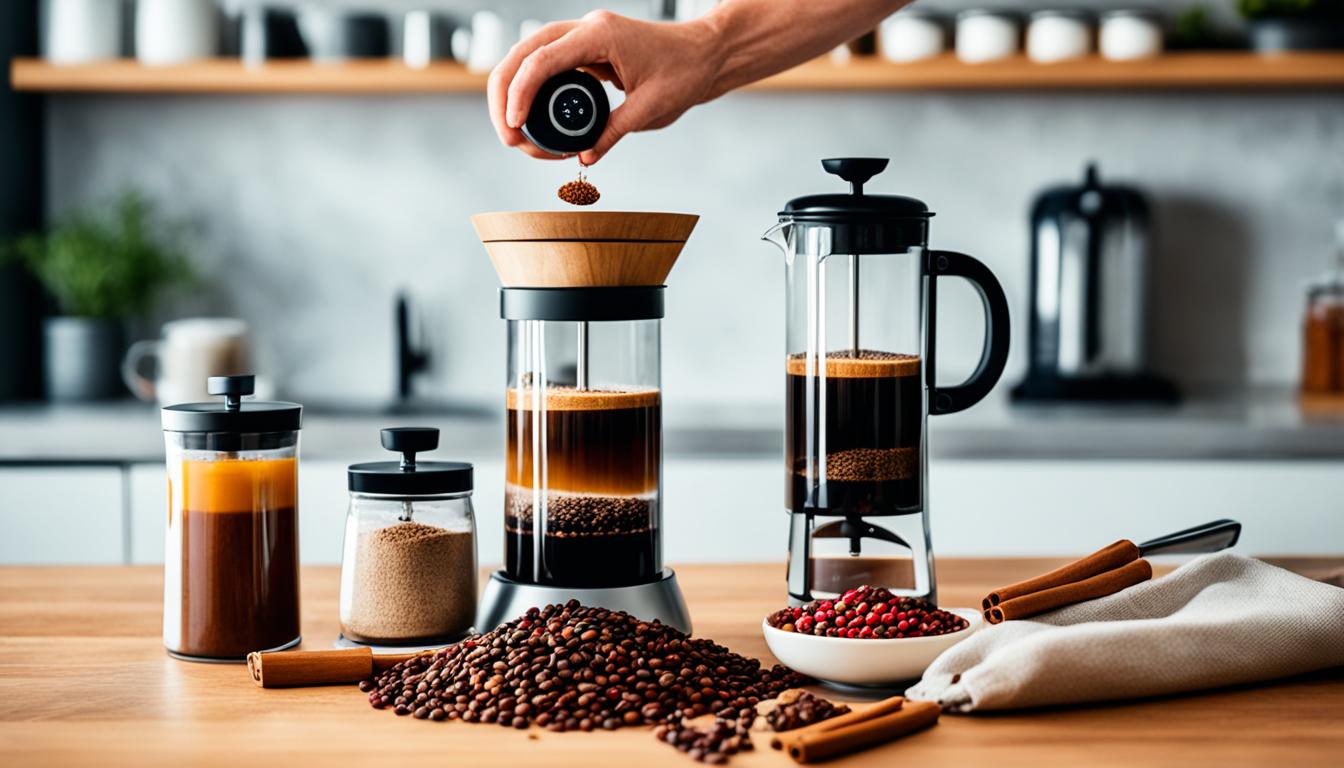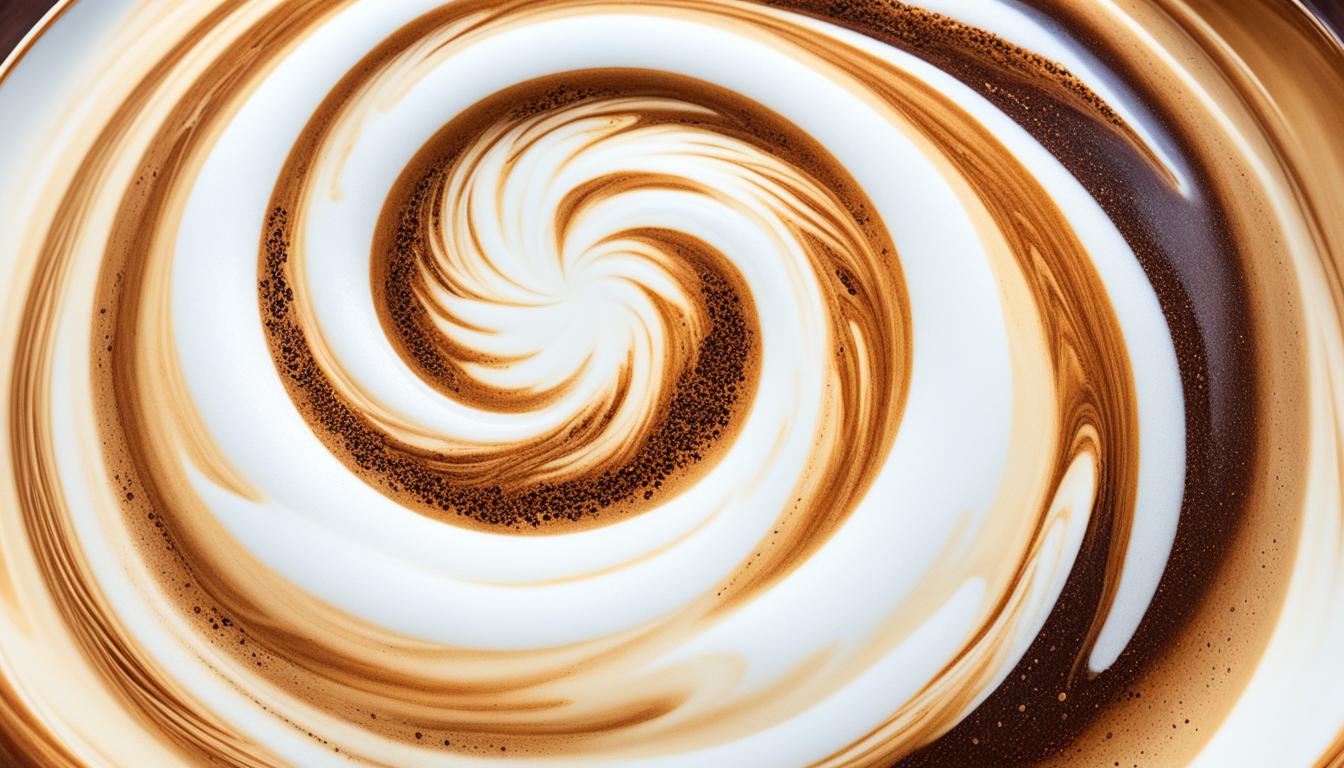There are many myths and misconceptions surrounding coffee brewing that can confuse even the most seasoned coffee drinkers. In this article, we will debunk these myths and reveal the truth behind them. We have gathered factual data from various sources to provide you with accurate information and expert tips on brewing the perfect cup of coffee.
Key Takeaways:
- Coffee brewing myths can be misleading and confusing.
- Understanding the facts can enhance your coffee brewing experience.
- Choose coffee that you enjoy and experiment with different brewing techniques.
- Store coffee properly to preserve flavor.
- Decaf coffee is not completely caffeine-free, but the amount of caffeine is minimal.
Does Grinding Coffee Beans Yourself Make a Difference?
Grinding coffee beans yourself is often considered the best way to ensure freshness and flavor in your cup of coffee. However, there are some myths and misconceptions surrounding this practice.
Many believe that grinding coffee beans yourself leads to a higher caffeine content in the coffee. However, according to Dr. Christopher Hendon, a computational materials scientist, the grinding process does not significantly affect the caffeine content of the coffee.
“The caffeine content of coffee is primarily determined by the variety and roast level of the coffee beans, not the grinding process,” says Dr. Hendon.
Pre-ground coffee from supermarkets may have slightly less caffeine due to oxidation, but the difference is minimal and ultimately comes down to personal preference. So, whether you choose to use pre-ground coffee or grind your beans yourself, it’s important to choose a coffee blend that you enjoy.
However, there are some advantages to grinding coffee beans yourself. Freshly ground coffee beans release more aroma and flavor compared to pre-ground coffee, which may have lost some of its freshness over time. Grinding your beans also allows you to control the grind size, which is crucial for different brewing methods.
To extract the best flavor from your coffee, consider investing in a quality grinder and experiment with different grind sizes to find the perfect balance for your preferred brewing method.
Expert Coffee Brewing Tip:
For a richer and more flavorful cup of coffee, it’s recommended to grind your coffee beans just before brewing. This ensures maximum freshness and flavor extraction.
Common Myths About Grinding Coffee Beans:
- Grinding coffee beans excessively fine will make the coffee bitter.
- Using a burr grinder yields superior results compared to blade grinders.
- Grinding coffee beans too coarse will result in weak and under-extracted coffee.
While some of these claims have some truth to them, the overall impact of the grinding process on the taste and quality of coffee is often overestimated. The best way to find your perfect cup of coffee is to experiment with different brewing methods, coffee blends, and grind sizes until you discover what works best for your palate.
Should You Store Coffee in the Fridge?
One of the most common debates among coffee enthusiasts is whether or not to store coffee in the fridge. To uncover the truth behind this brewing myth, we turned to the expertise of Dr. Hendon.
According to Dr. Hendon, the key to preserving the flavor of your coffee lies in proper storage. Coffee should be stored in a dry and airtight container to prevent moisture from seeping in and compromising the flavor. While refrigeration may seem like a logical solution, it can actually lead to the loss of volatile flavor molecules over time.
For optimal flavor preservation, it is recommended to store coffee at room temperature in a cool, dark place. This will help maintain the aroma and taste of your coffee for a longer period.
| Storage Method | Impact on Coffee Flavor |
|---|---|
| Refrigeration | Loss of volatile flavor molecules over time. |
| Room Temperature Storage | Optimal flavor preservation. |
By following this simple tip, you can avoid one of the common coffee brewing mistakes and ensure that each cup of coffee you brew is packed with the delicious, vibrant flavors you love.
Expert Tip:
“To preserve the flavor of your coffee, store it in a dry and airtight container at room temperature. Avoid the fridge, as refrigeration can affect the taste over time.” – Dr. Hendon
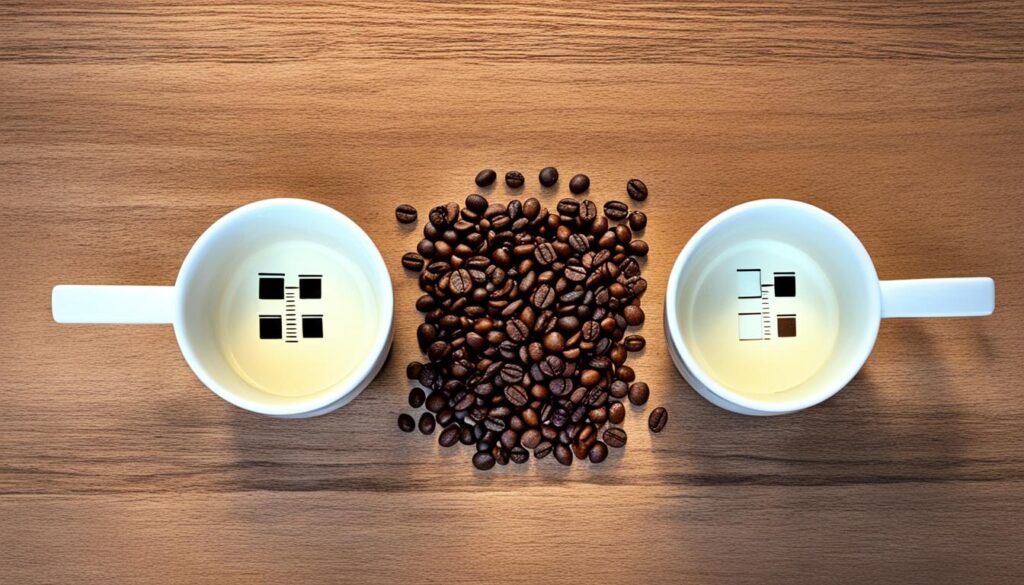
Is Cold Brew More Caffeinated than Hot Coffee?
Contrary to popular belief, hot coffee actually contains more caffeine than cold brew. The extraction process is limited by temperature, and cold brew is typically diluted or mixed with milk, resulting in a lower caffeine content. While cold brew can still be high in caffeine, it is not because of the extraction method but rather the concentration of coffee used. On average, a hot coffee brew has about twice the amount of caffeine compared to cold brew.
Key Takeaways:
- Hot coffee contains more caffeine than cold brew.
- The extraction process in cold brew is limited by temperature.
- Dilution and milk mixing in cold brew lower its caffeine content.
- Average hot coffee brew has about twice the caffeine compared to cold brew.
Can Coffee Be Burnt During the Brewing Process?
Many coffee enthusiasts believe that coffee can be burnt during the brewing process, but this is actually a common myth. When coffee is roasted, it undergoes a chemical transformation that results in different flavors and aromas. The roasting process involves exposing the green coffee beans to high temperatures, typically between 400°F and 450°F, for a specific duration.
During brewing, the water temperature typically ranges between 195°F and 205°F, which is significantly lower than the temperatures used in roasting. This means that the brewing process cannot replicate the high temperatures required to burn coffee. Coffee beans are resilient and can withstand the brewing temperatures without burning.
It’s important to note that certain coffee beans may have a burnt taste due to the roasting process itself. The degree and duration of the roasting can affect the flavor profile of the coffee. Darker roasts, such as French or Italian roasts, are roasted for a longer time, resulting in a richer and more intense flavor that some might perceive as being burnt.
To avoid a burnt flavor in your brewed coffee, you can opt for a lighter roast. Lighter roasts are typically roasted for a shorter duration, allowing the natural flavors of the beans to shine through without the presence of a burnt taste. Experiment with different roast levels to find the flavor profile that suits your taste preferences.
“The brewing process cannot replicate the high temperatures of coffee roasting, so it is not possible to burn the coffee during brewing.”
Frequently Asked Questions about Burning Coffee
Q: Can I burn coffee if I leave it on the heat for too long?
A: While excessive heat can adversely affect the flavor of coffee, it doesn’t burn the coffee in the traditional sense. Prolonged exposure to heat can cause the coffee to become overly bitter or develop off-flavors, but it won’t result in the coffee catching fire or turning into ash.
Q: Is it possible to salvage coffee that tastes burnt?
A: If you’ve brewed coffee that tastes burnt, there are a few things you can try to improve the flavor. One option is to dilute the coffee with hot water or milk to lessen the intensity of the burnt taste. Additionally, adding a pinch of salt can help counteract the bitterness. However, keep in mind that these methods may not completely eliminate the burnt flavor.
Coffee Roast Levels and Flavor Profiles
| Roast Level | Color | Flavor Profile |
|---|---|---|
| Light | Light brown | Subtle acidity, delicate flavors, floral and fruity notes |
| Medium | Medium brown | Balanced acidity, caramel and nutty flavors with less acidity |
| Dark | Dark brown to almost black | Bold and rich flavors, lower acidity, hints of chocolate and caramel |
Is Decaf Coffee Completely Caffeine-Free?
When it comes to decaf coffee, there’s a common misconception that it is completely caffeine-free. However, that’s not entirely true. While the decaffeination process removes the majority of caffeine from the coffee beans, trace amounts may still remain.
According to Dr. Hendon, renowned coffee expert, the decaffeination process is highly effective in removing caffeine, with close to 100% caffeine removal. However, various tests have found that even after this rigorous process, there are minimal amounts of caffeine present in decaf coffee.
Although the caffeine content in decaf coffee is significantly lower compared to regular coffee, it’s important to note that it might not be completely free of caffeine. The exact amount can vary from one brand to another and even batch to batch.
However, the trace amounts of caffeine found in decaf coffee are so minimal that they are unlikely to have any noticeable effect on the drinker. This makes decaf coffee a suitable choice for those who are sensitive to caffeine or prefer to limit their intake.
“Decaf coffee may not be entirely caffeine-free, but the small amount of caffeine remaining is negligible and shouldn’t affect most people.”
To ensure that you are getting the least amount of caffeine possible, it’s crucial to choose a reputable brand that follows strict decaffeination processes. Additionally, consider opting for water-processed decaf coffees, as they are often perceived to have a more natural taste compared to those processed with chemicals.
Now that we’ve debunked the myth surrounding decaf coffee, you can confidently enjoy your cup of decaf without worrying about high caffeine content.
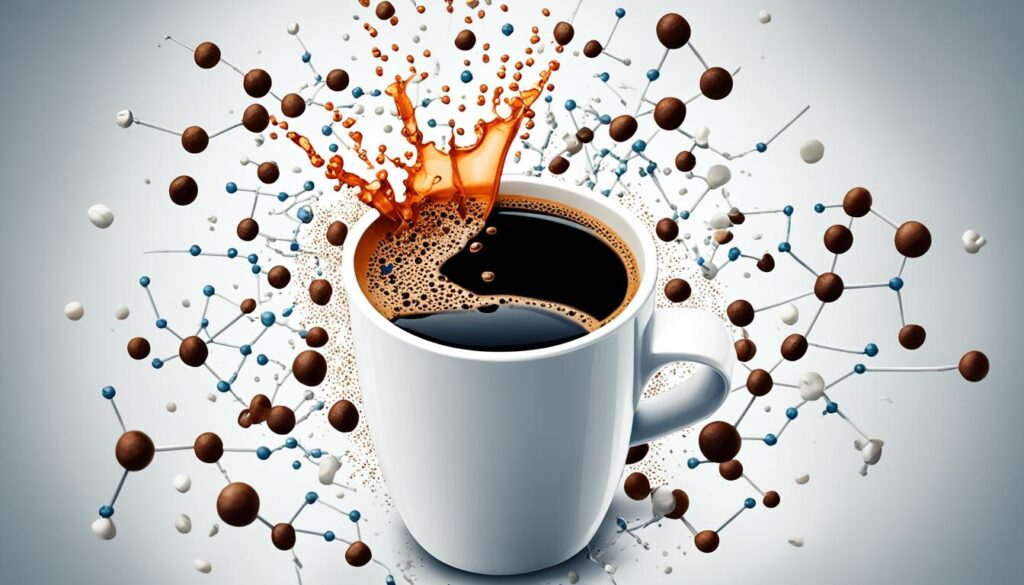
The Myth: Decaf coffee is completely caffeine-free
The Truth: Decaf coffee contains trace amounts of caffeine, though the quantity is minimal and unlikely to have any noticeable effect on the drinker.
Conclusion
Coffee brewing myths can often lead to confusion and misinformation. However, armed with the right knowledge, you can unlock the secrets to brewing the perfect cup of coffee. By debunking these common myths, we hope to empower you with expert coffee brewing tips that will elevate your coffee drinking experience.
When it comes to brewing coffee, it’s essential to choose a coffee blend that you enjoy. Whether it’s pre-ground or freshly ground, the key is to prioritize the flavor and aroma that suits your taste buds. Experimenting with different brewing techniques, such as pour-over, French press, or espresso, can also help you discover new and exciting flavors.
Proper coffee storage is another crucial aspect to preserve the freshness and flavor of your beans. Opt for a dry, airtight container and store your coffee at room temperature in a cool, dark place. Avoid storing coffee in the fridge, as it can impact the flavor due to moisture absorption.
By debunking these myths and following expert coffee brewing tips, you can take your coffee brewing skills to new heights. Embrace the joy of crafting the perfect cup of coffee by understanding the facts and experimenting with different variables. The journey to the perfect brew awaits you. Happy brewing!
FAQ
Does grinding coffee beans yourself make a difference?
The grinding process does not significantly affect the caffeine content of the coffee. Choosing a coffee blend that you enjoy, whether it’s pre-ground or freshly ground, is more important.
Should you store coffee in the fridge?
Storing coffee in a dry and airtight container at room temperature is recommended for optimal flavor preservation. Storing coffee in the fridge can lead to the loss of volatile flavor molecules.
Is cold brew more caffeinated than hot coffee?
Hot coffee actually contains more caffeine than cold brew. The extraction process is limited by temperature, and cold brew is typically diluted or mixed with milk, resulting in a lower caffeine content.
Can coffee be burnt during the brewing process?
The brewing process cannot burn coffee. However, certain coffee beans may have a burnt taste due to the roasting process itself. Opting for a lighter roast can help avoid this flavor.
Is decaf coffee completely caffeine-free?
Decaffeinated coffee is not completely caffeine-free. The decaffeination process removes most of the caffeine, but trace amounts may still be present. The amount is minimal and unlikely to have any noticeable effect.

